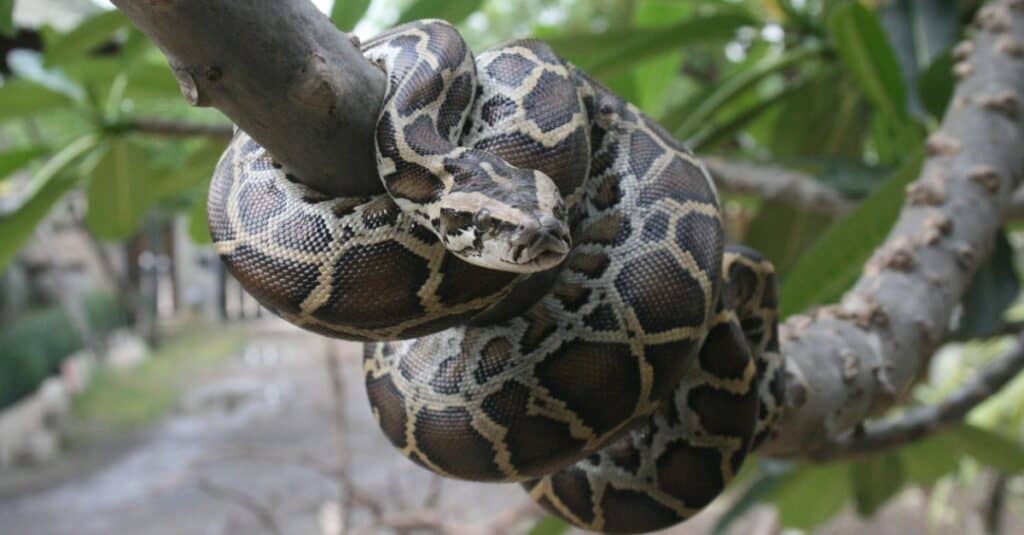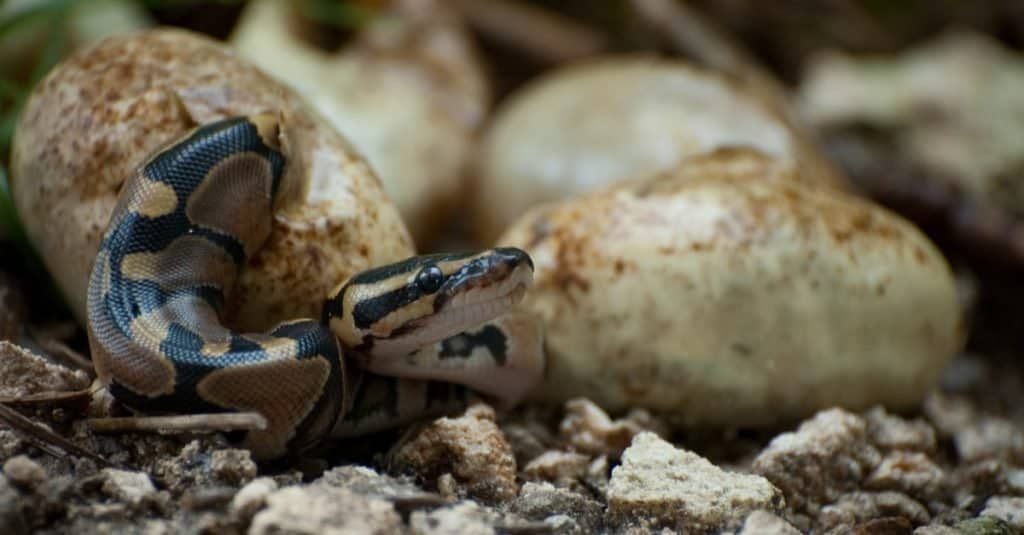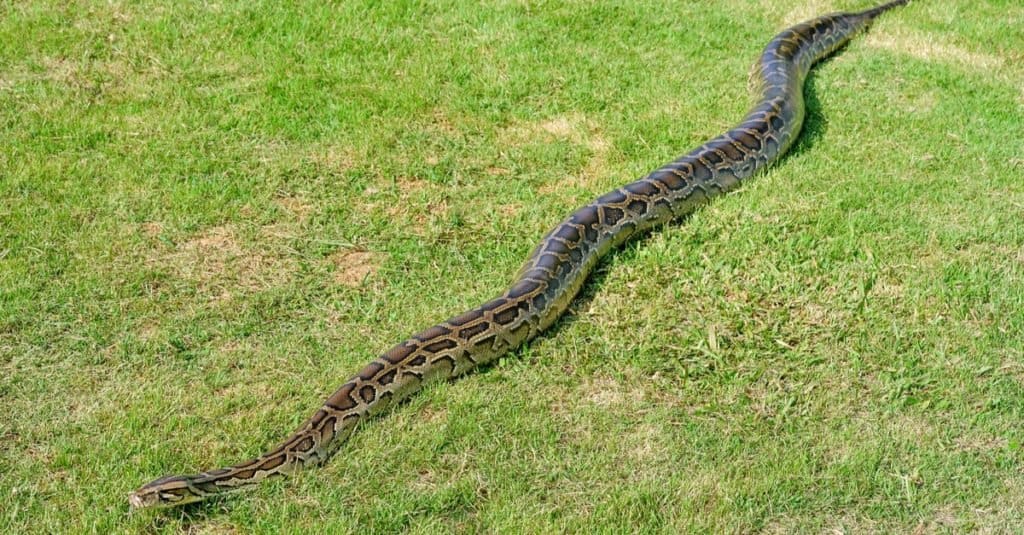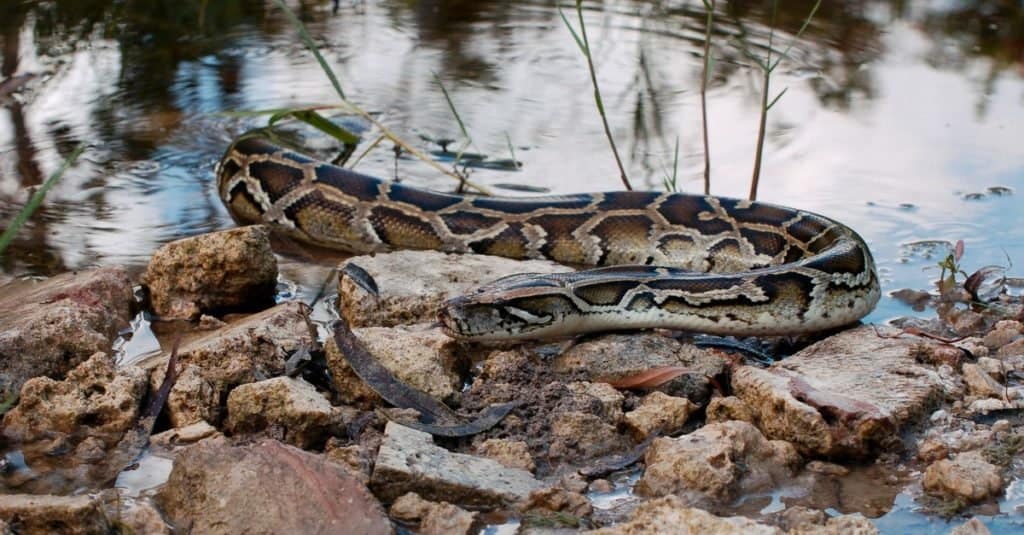Burmese pythons are becoming an increasingly large problem in Florida. This invasive species of snake is causing severe ecological problems, devastating native animal populations. Not helping matters is the fact that it’s one of the longest snakes in the world, helping it rise to the top of the food chain. In this article, we’re going to see exactly why Burmese pythons were able to invade Florida and what humans are doing to fight back against them.
How Burmese Pythons Got to Florida

The Burmese python is able to swallow animals as large as a deer.
©iStock.com/Lunatic_67
Pull up a map of the world and look where Burmese pythons originate. You’ll quickly see that they are naturally occurring in Southeast Asia. How in the world did these reptiles get to Florida in the United States, a distance of over 8,000 miles?
Currently, two theories exist for how these snakes got to Florida in the first place. Take a look and see how relatively small actions can have a massively negative impact on the environment.
Theory 1: Burmese Pythons Were Dumped by Pet Owners
The first theory about how Burmese pythons were introduced into the United States is that they were dumped by exotic pet owners during the 1980s. These snakes were shipped into the U.S. so that people in Florida could keep them as pets.
Eventually, the snakes got too large, too expensive, or otherwise became a hindrance on the owner. They allowed the snakes to go free in the Florida Everglades, and the rest is history. This theory is considered to be the true genesis of the invasive species. Yet, the problem was exacerbated by other factors.
Theory 2: Burmese Pythons Escaped Due to a Hurricane
The second theory about how Burmese pythons got released in Florida is that Hurricane Andrew destroyed breeding and holding facilities with the snakes in 1992. These breeding facilities, used to research the snakes, held many specimens.
When people evacuated in the face of the 150 mph winds brought by the hurricane, these snakes were left behind. As roofs blew off and glass shattered across the state, these snakes got free of their housings and fled into the wild.
Since these snakes were in the facility to breed, they eventually bred and unleashed a massive generation of snakes into the wild. However, Burmese pythons were already present before 1992, so this was not the outset of the invasion. Yet, the release of these pythons certainly added to the problem in a significant way.
Why Burmese Pythons Were Able to Invade Florida

Burmese Pythons Hatching
©Heiko Kiera/Shutterstock.com
The Burmese python is not native to Florida, so how did it manage to survive? Why is this the only place in the U.S. where these snakes thrive so well despite having exotic pet owners throughout the country? Let’s examine the unique factors in Florida that allowed the snake to thrive here.
Burmese Pythons Have Few Natural Predators in Florida
A Burmese python can grow up to 23ft long and weigh 200lbs. They can hunt and eat small animals like rabbits and foxes as well as large ones like deer. There was even one case where a large snake tried to eat an alligator until it burst open.
These snakes have no problems surviving in this area of the world because they only have two real predators in the area as adults: humans and alligators. Aside from that, there is not much to quell their growth. Also, it helps that they are not picky eaters and will thrive on all sorts of animals!
Burmese Pythons Hide Extremely Well
Burmese pythons are ambush predators. They spend a lot of their time in tall vegetation and near bodies of water. They can climb and swim well. Also, they are usually only active at dusk or nighttime, so they’re even harder to spot. Even professional hunters have trouble finding these snakes.
Burmese Pythons Can Lay up to 100 Eggs Per Year
Lastly, Burmese pythons can breed quickly. Every year, a single female can lay anywhere between 10 and 100 eggs. Although not all of those snakes will survive to adulthood, enough of them do and keep the population growing.
Aside from their ability to breed quickly and avoid dying at the paws and talons of other creatures, the climate is just right. These snakes thrive in warm, humid areas, and that’s something that Florida offers. Currently, Burmese pythons are a rarity outside of Florida. Yet, we must consider if they are done spreading.
The Impact of Burmese Pythons on Florida

Burmese Python stretched out on grass., looking for its next meal.
©Yatra/Shutterstock.com
The Burmese pythons in Florida have devastated the mammal population in the Florida Everglades. A 90% reduction in the numbers of bobcats, foxes, raccoons, and other animals that once thrived in the area has been witnessed. The marsh rabbit population has been completely wiped out in the area.
These snakes have negatively transformed the ecology of the area, and they continue to spread farther north in Florida. That puts them in close contact with greater numbers of animals, pets, and people. Although no human fatalities have been witnessed in the United States, excessively large pythons have killed in other countries and could get bold enough to do the same.
Needless to say, the impact of these pythons is nothing short of enormous, and it could get worse.
Turning the Tide Against the Snakes

A Burmese python lurks in the Everglades.
©Heiko Kiera/Shutterstock.com
Currently, it’s estimated that anywhere between 30,000 and 300,000 Burmese pythons inhabit Florida, but it’s difficult to measure their numbers. After all, the snakes are very hard to find, and some modern tools are hard to use on cold-blooded creatures.
Nevertheless, 5,000 of the snakes have been removed from the Everglades in recent years. Regular hunts, the removal of hunting licenses for the creatures, and government-sponsored reporting systems have helped reduce the number of pythons. However, more impactful measures may be needed to get rid of the snakes in greater numbers.
Overall, several reasons exist why Burmese pythons were able to invade Florida and thrive in the area. Fortunately, the snakes seem to be trapped in the state because they can’t stand cold weather. That might be the only thing truly stopping this snake from becoming an even more troublesome invasive species in the future.
The photo featured at the top of this post is © Heiko Kiera/Shutterstock.com
Discover the "Monster" Snake 5X Bigger than an Anaconda
Every day A-Z Animals sends out some of the most incredible facts in the world from our free newsletter. Want to discover the 10 most beautiful snakes in the world, a "snake island" where you're never more than 3 feet from danger, or a "monster" snake 5X larger than an anaconda? Then sign up right now and you'll start receiving our daily newsletter absolutely free.
Thank you for reading! Have some feedback for us? Contact the AZ Animals editorial team.






